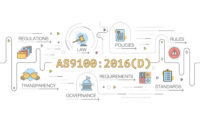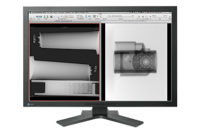As the cliché goes, quality is an endless journey. Irrespective of your performance as a supplier, when it comes to customer expectations, there is only one way: up. And if you happen to be involved in a highly regulated supply chain, such as in commercial aerospace, regulatory agency oversight is always a key aspect of your quality system. So, robust quality management systems (QMS) are a must-have if you want to be part of this exclusive club of providers of aviation, space and defense products. Simultaneously, but conversely, organizations resent being forced (by customers) to adjust or improve standards of performance they are subjected to.
With that context as a background, the International Aerospace Quality Group (IAQG) had a lot of work to do when we embarked on the transition to the 2009 Edition of the AS9100, AS9110 and AS9120 standards several years ago. Interesting to note that, in hindsight, the easiest part of the transition process was actually the revision to the three core standards mentioned above. The part of the transition process that proved to be more challenging and involved had to do with the conformity assessment practices, rules and protocols necessary for the certification of aerospace supplier’s quality systems. And, because the Industry Controlled Other Party (ICOP) augmented accredited certification process needs to deliver confidence on a global scale, a few other documents had also to be revised accordingly. Documents such as the AS9101 standard that controls how audits performed by certification bodies have to be planned for, executed and reported on; documents such as AS9104/1, which establishes policies and requirements on how registrars have to manage the certification programs used to register the thousands of certified suppliers into the Online Aerospace Supplier Information System (OASIS www.iaqg.org/oasis) database. In addition to all of the requirements established in these two documents, the IAQG also made use of Supplemental Rules (SR) to provide additional guidance to the process of transitioning the approximate 15,000 certificates in OASIS to the AS91X0:2009 version.
For a better understanding of the interrelationship of the numerous standards developed and endorsed by the IAQG, let’s have a look at this chart developed by the IAQG Requirements Strategy Stream:
While AS9100, 9110 and 9120 are a focal point of the IAQG Industry initiatives, as one can tell, there are many more documents in the portfolio. At the very top part of the chart, the AS9104-1, AS9104-2 and AS9104-3 documents provide for criteria and requirements necessary for a robust and confidence-assuring certification process, which, together with the previously mentioned AS9101 document, should result in third-party audits that not only confirm that the systems being audited are in conformity with the (regulatory, contractual, customer and self-imposed) requirements, but and as importantly, the system is able of consistently delivering the ultimate QMS goals of providing products that are in full conformity with specifications, are delivered on-time and on-cost and, finally, customers are consistently satisfied, while realizing a financial profit.
To that extent, Revision D of the AS9101 standard became a game changer in the world of management system auditing because, for the first time ever, auditors are expected to formally delve and report on the organization’s business processes effectiveness in reaching results. To that effect, AS9101 Revision D introduced a new mandatory form, used by aerospace third-party auditors to report on the perceived effectiveness of the business processes in delivering results: the Process Effectiveness Assessment Record (PEAR) form. One of the lessons derived from this change is the need for organizations to have quantifiable indicators associated with their business processes, so a measure of effectiveness can be derived.
Because of the strong process-approach to QMS implementation imposed by the protocols set forth in AS9101 Revision D, we have also learned that many organizations have been deemed compliant with ISO 9001 and/or AS9100 for many years, without truly understanding the process approach to a QMS implementation. The latest version of AS9101 forced auditors to apply more focus and keep organizations accountable to that principle embedded in AS9100. We have come to a realization that, sometimes, only when external auditors are compelled to report certain aspects of the certified system, they will leave their comfort zone and enforce some non-traditional requirements of the standards and, only then, start driving real change in the supply chain.
Coming back to the chart above, the IAQG learned that, try as you might to transfer knowledge to the supply chain via initiatives such as the Supply Chain Management Handbook (SCMH www.iaqg.org/scmh), the vast majority of organizations and professionals affected by their international initiatives limit their involvement solely with the aspect of attaining and maintaining certification to the standards demanded by their customers and nothing more, ignoring a wealth of information contained in either guidance standards and/or free knowledge provided via the SCMH website.
From the OEM and major primes perspectives, the AS9100 Rev. C transition process allowed them to revise the standards in a way to broaden the scope of coverage, and add new stakeholders to the fold. For example, while the previous versions of the AS 91X0 standards had a clear focus on aviation (commercial and military) “flight hardware,” with some modifications to the requirements, stakeholders from the Defense and Space sectors now feel included and engaged in the development and review of the documents. Further, large stakeholders in the Defense and Space sectors are now also relying on the IAQG ICOP Scheme as a potential component of supplier oversight, what represents a welcomed change to the thousands of suppliers that deal with customers in all the three sectors and appreciate the reduction of external second-party audits.
Changes
While most of the changes to the AS9100 standard were welcomed and embraced almost universally, there were a couple of controversial changes which are being rethought by some of the affected parties. For example, Revision C of AS9100 deleted a previous existing requirement for organizations to periodically validate the results of Certificates of Conformity (CoC) and/or test reports, when using these evidence as means of incoming product acceptance. For at least one major U.S. based aerospace OEM, that deletion represents some risks that they are not willing to accept, so the requirement now absent from the standard will be incorporated as a quality clause in the organizations’ flown down contractual requirements.
Another very important stakeholder category in the transition process, the CB auditors, found out that the IAQG was very serious about heightened expectations related to audit results and, via the mandatory, four-day long Aerospace Auditor Transition Training (AATT www.iaqgtraining.com), auditors were re-indoctrinated in the audit protocol that, as previously mentioned, require audit teams to go beyond the decades-old, traditional approach of auditing as an exercise in verification of conformance to requirements only, but also assess and report on the organizations’ processes effectiveness in delivering results, from a product conformity, on-time delivery and customer satisfaction perspectives. To a significant percentage of the authenticated aerospace auditors working in this industry, that change did not come easy.
The IAQG also learned that, despite its best efforts in terms of creating a single AATT course platform and mandating instructor qualification and specific training provider approvals to minimize variation in the training process, instructor inconsistency still exists and such variation can create concerns when you are trying to roll out a global and harmonized auditor re-approval process where many languages are involved.
CB auditors found that the new AS9101 Revision D standard had also increased the amount of records generated as part of the audit package and one of the early feedbacks to the IAQG had to do with the excessive amount of time being spent to fill out the paperwork associated with the numerous appendices contained in AS9101D. To that effect, the IAQG promptly acknowledged the issue and triggered a review and revision process to the AS9101 Standard, and at the time of this writing, Revision E of the 9101 standard is being balloted and the revised document is expected to bring less demanding requirements for evidence collection during the audits performed by registrars.
As the mandatory AATT course focused primarily on the audit protocols and learning the requirements contained in AS9101, some of the new requirements contained in AS9100, such as Risk Management and Project Management could not be covered, extensively, in terms of formal interpretations. As a way of mitigating the risks associated with excessive variation amongst auditors and registrant organizations, the IAQG developed a number of supporting documents and made them available online, at no charge. The documents can be accessed via www.sae.org/iaqg/organization/requirements.htm#ipr and they include the following:
Deployment Support Materials
• 9100 - Quality Management Systems: Aviation, Space and Defense Organizations
• 9100 Press Release
• Changes Presentation
• FAQ
• Clarifications and Published Standards - 9100:2009 (Based on ISO 9001:2008 Standard)
• 9100 Changes and Rationale
• 9100 Auditor Guidance Material
• 9101 - Quality Management Systems - Quality Management Systems 9101 - Audit Requirements for Aviation, Space and Defense Organizations
• 9101 Press Release
• Changes Presentation - Revised August 2011
• FAQ
• 9110 - Quality Management Systems - Aerospace - Requirements for Maintenance Organizations
• 9110:2012 Press Release
• 9110:2012 Revision Summary
• 9110:2009 Press Release
• 9110:2009 Revision Overview
• FAQ
• 9120 - Quality Management Systems - Distributors
• 9120 Press Release
• Changes Presentation
• 9104-1 - Requirements for Aviation, Space and Defense Quality Management System Certification Program
• FAQ
• Certification Structure Oversight Committee (CS OC) Information and Guidance Materials
An additional lesson learned from the transition process is the fact that communication about expectations about the value of certificates, what the industry is trying to accomplish with the ICOP certification process and how and why audit protocols are changing is paramount and the IAQG could improve on that respect. With the adoption of AS9101 Rev. D, certification bodies and their respective third-party auditors had to change the audit process in a number of ways. Unfortunately, the vast majority of the registered organizations were unaware of the changes being imposed by that standard and, indirectly, how those changes would affect their audits and certificate programs. Because of that, some unnecessary friction was created between registrars and clients. Some enlightened people, realizing the need to educate their clients and interested parties on the forthcoming changes, ran webinars and other means of conveying the industry-mandated changes, but I am positive that one of the major lessons we all learned from the last transition process was the need for better communication coming from the IAQG to registered organizations so the whole certified supplier base hears the same message.
As one of the IAQG five-year vision is for us to have a Quality Management System certification program which is robust, recognized and valued, I am sure that such lessons have been learned and improvements will be made to the next transition cycle. Revision D of AS9100 is underway and it is possible we might see that edition of the standard during the first half of 2016. While it is way too early to speculate on the timeframe for the AS9100 Rev. D Transition, it is possible we will see the first AS9100 D certificates being issued in 2017, and, by then, customer expectations will certainly be higher than they are today.
|
TECH TIPS
|
•





